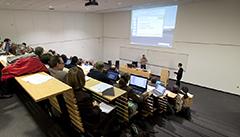
Sciences & Société
Soutenance de thèse : Ruifen ZHANG
Patient specific imaging-based modeling of vessels. Application to the assessment of pathologies in the thoracic aorta
Doctorante : Ruifen ZHANG
Laboratoire INSA : CREATIS
Ecole doctorale : EDA160 : Électronique, Électrotechnique, Automatique
This thesis is focused on the investigation of the mechanical properties of the aorta wall in the context of ascending thoracic aneurysms. Cardiovascular diseases are the leading cause of death worldwide (30% of total mortality). In the cardiovascular disease landscape, the ascending thoracic aorta aneurysm (ATAA) is one of the major pathologies of the aorta. ATAA is associated with a high morbidity and high mortality rate in case of acute events (rupture and/or dissection). But the epidemiology of ATAA is difficult to investigate because it is a clinically silent disease. ATAAs are asymptomatic in >95% of cases, meaning most of them remain undetected unless incidentally discovered. Once diagnosed, the clinical decision could either be to monitor the ATAA with imaging or to perform a surgical intervention. Despite advances in intensive care and surgery, intervention related mortality is still as high as 25%. The decision for ATAA surgical repair is mostly based on size, speed of growth, symptoms and family history or connective tissue disorders. These mainly morphological parameters are poor predictors of acute events, i.e. dissection or rupture of the aortic wall. Functional parameters such as blood flow and mechanical properties of the arterial wall itself provide additional information that may aid the clinical decision making. Consequently, in the last decade, a direction in research has focused on the investigation of these mechanical parameters using finite element modeling (FEM). FE modeling can help establish more accurate diagnosis and provide additional clinical and surgical information. From the mechanical point of view, the hypothesis is that the rupture of aneurysm occurs when the wall stress exceeds the wall strength. Therefore, the evaluation of the aorta’s mechanical properties can help to better stratify patients in need of intervention and potentially improve risk assessment. The aim of the present work was to develop an inverse approach for patient-specific biomechanical aorta modeling from medical imaging data, in order to regionally quantify the material properties of patient’s aorta and compute the stress maps. After introducing the medical and the biomechanical context (Chapter 1), Chapter 2 provides an overview of the methodological aspects for forward and inverse FE Modeling of vessels. Our proposed methodological workflow is illustrated on one patient dataset. In chapter 3, we provide an overview of the concepts relevant to the development of constitutive laws for fiber-reinforced materials and in particular the anisotropic Holzapfel-Gasser-Ogden (HGO) law that we selected for aorta tissue modeling. The implementation of the HGO law within Abaqus is validated using a thick-wall cylinder under combined extension and inflation for which a numerical reference can be assessed. The forward FE modeling procedure is described and studied in Chapter 4 on both synthetic idealized geometries and patient specific geometries. Notably, a sensitivity study of the HGO law parameters onto geometric factors, deformation and stress is presented and will be used to control the inverse optimization. Finally, the inverse modeling approach for the estimation of patient specific model’s parameters is introduced and discussed in Chapter 5 on well controlled synthetic cases. Our first results from patient 3D-CT data are presented. The report ends with a summary of our main contributions and findings, and the perspectives of this work.
Informations complémentaires
-
Amphithéâtre Emilie du Châtelet - Bibliothèque Marie Curie - INSA Lyon

